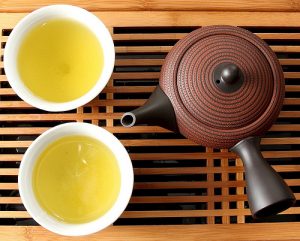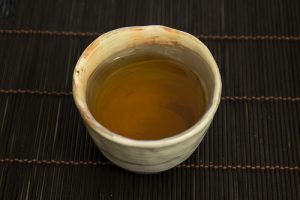
Did you know that once brewed, you can still get more flavor out of your green tea leaves?
You do so by re-steeping. Basically, all you have to do is add more water and brew again. It’s a good way to save on expensive green teas.
Unlike other types of tea like oolongs and post-fermented teas, which can be re-steeped a high number of times, green tea leaves are limited by their delicate nature.
The basics of re-steeping
Let’s say that you wanted to fully extract the flavor from your tea leaves into your cup of tea. What should you do?
Well, you can try boiling water and then steeping for a very long time. The problem is that the resulting tea is very astringent and bitter, basically making it undrinkable.
Since different compounds extract at different rates depending on water temperature, you need a certain balance to get the best flavor. That’s what steeping guidelines are all about, otherwise all green teas would be brewed in boiling water.
So then, how to fully enjoy the flavor of your green tea? The solution is to make multiple infusions.
After the first infusion, the tea leaves still have soluble compounds that you can extract. Although there’s a limit (at later infusions you can barely taste any tea), it’s fun to try the different flavors each time.
There aren’t any hard rules for water temperature and brewing time for multiple infusions, so it’s mostly a matter of preference.
For example, some people like to increase the temperature a little after each re-steep, others increase/decrease the brewing time as well, and some people just do the same as they did on the first infusion each time.
I recommend that you start with the 3rd option, and modify from there.
By the way, decreasing the water temperature won’t do any good, it’ll just take longer for your next infusion. The reason why people use a higher temperature is to increase the extraction rate.
Re-steeping Gyokuro
Gyokuro is usually re-steeped up to four times, although it’s common to stop at the third infusion. After the fourth, it tastes quite weak.
Have you noticed that the characteristic flavor of gyokuro (sweetness and umami) is almost absent after later infusions (at the same temperature and brewing time), and you begin to taste bitterness and astringency that weren’t noticeable before?
To begin with, the amino acid content in gyokuro leaves, especially L-theanine, is low compared to the catechin and caffeine content. Furthermore, the standard way of brewing gyokuro is meant to maximize the extraction of L-theanine (sweetness) while minimizing that of catechin and caffeine (astringency and bitterness).
That means that after the first infusion, a good amount of the amino acids have been extracted but there’s plenty of catechin and caffeine left for later infusions!
I suggest that you don’t increase the temperature too much when re-steeping gyokuro, especially for the second one. I’d rather increase the steeping time, otherwise the delicate flavor may be ruined.
Re-steeping sencha
In Japan, sencha is rarely steeped more than three times. Of course, this depends on the specific sencha, and also your preferences.
I find that with a sencha that I like a lot, I’ll go up to the fourth infusion, but after that it’s not really worth it. The flavor is almost gone by then.
With fukamushi sencha, I find that a fourth infusion still tastes ok and the color isn’t that pale, only the aroma suffers. I believe it’s due to the small leaf particles present in this type of tea.
Re-steeping bancha

Bancha and other types of tea made with it, such as genmaicha and houjicha, have a very limited number of infusions. No more than two in most cases.
In genmaicha it’s very hard to get past two, because the roasted rice gives off most of its flavor in the first infusion 🙁
Also, since they don’t have much L-theanine content, they are brewed with boiling water. That means that all you can do is just use the same brewing time, or perhaps increase it for your next infusion.
Things to keep in mind
- Keep the standard amount of tea leaves and use the same volume of water each time. If you get more infusions but you’re doing it with more initial tea and/or less water, you’re cheating 🙂
- Re-steep as soon as you can, leaving the tea leaves wet makes them prone to degradation.
- If brewing on a teapot, serve each infusion until the last drop. Otherwise there will be liquid with the leaves still brewing between infusions, which will alter your results.
- Keep re-steeping until you don’t enjoy the tea anymore. You don’t have to re-steep for the sake of it, it’s all up to you.





July 9, 2013
I think you got that bit about Gyokuro mixed up. What I’ve been taught is that shading INCREASES theanine and DECREASES catechins, which makes sense since Gyokuro is prized for its greater umami and lower astringency. Here is also a link from a Japanese tea farm’s blog which supports this:
http://obubutea.com/4269/what-are-the-differences-between-different-sencha-types/
July 10, 2013
Hello Sergey
Yes, gyokuro has more amino acid content that other Japanese teas. However, the total content of amino acids in gyokuro is still only about 1/3 of the sum of it’s catechin and caffeine content.
Sorry if I expressed myself poorly.
Source: 日本茶のすべてがわかる本, year 2012, page 24
September 24, 2013
Hi,
Actually I’ve been having issues with my re-steeped sencha. It just doesn’t seem to have any of the flavor of the first brew. I’m thinking of raising the temperature since the time is already at 5 minutes. How high do you think the temperature can go without burning the leaves?
September 24, 2013
Hello, thank you for your comment.
Perhaps you’re taking off most of the flavor in your first infusion?
First, make sure you’re using the right brewing guidelines: leaf/water ratio, temperature and time.
After the first steep, basically there are no hard rules. So if you want to increase the temperature all the way to boiling, and the taste works for you, go ahead and do it.
Usually I keep the same or a bit higher temperature and increase the steeping time, but 5 minutes I think is kind of excessive.
Note that the flavor isn’t the same as the first brew, but it should be enjoyable.
April 13, 2019
what I can think of right there is you are brewing sencha the western way- in Japan, they typically steep sencha at 80 deg, with 10g (2 tbsp leaves) per cup (~200-250 ml) for 1 minute. For resteepings, I find that the flavor actually becomes more pronounced even though I steep for slightly less time. I’m guessing you are either steeping too few leaves, for too long, or are using a lower quality tea. Fix those and there should be no more issues imo.
September 24, 2013
Thanks for responding, Ricardo. I think maybe you’re right about taking away most of the flavor on the 1st infusion.
The directions say to use 1/2-1 teaspoon per large cuppa tea and steep at 175 degrees for 3-5 minutes (not sure what large cuppa tea means).
I have been using 2 teaspoons in 500 ml of water at 175 degrees. A few days ago, I thought I brewed it for 4 minutes on the 1st infusion and it tasted amazing, but then I did the same yesterday and it wasn’t strong enough, so I bumped it up to 5 minutes. I am sure it’s something simple I need to fix.
September 25, 2013
My re-steeping guidelines apply to Japanese-style brewing.
My biggest yunomi holds only about 100 ml of water, and I use one teaspoon of sencha and brew for a minute.
For the same results, I guess you should use more tea leaves, 1 teaspoon for 250 ml of water seems kind of low to me.
September 26, 2013
Thanks for the tips and response!
September 19, 2014
I’m looking for input. I’m a bit off topic though related. I’m new to tea to replace unhealthy coffee. After a few unpleasant shelf brands I discovered Gyokuro. The tea shop rep said I could infuse it 5 times, but gave no instruction. Here’s my method. What am I missing out on? The flavor is good though suffers a slight bitter aftertaste. To save time and money I use my pause-drip coffee maker bin with a rinsed paper coffee filter. I use 2 tsp. of leaves. Heat water separately to 175, pour 16oz into bin, wait 45 secs and put warmed thermalpot on to drain the bin. Enjoy the first cup, but repeat steeping adding 15 secs to each infusion. With the volume I use, I only steep 4 times to get the morning supply of 3 – 4 12 oz mugs o tea. The flavor is good(ish) even with all the combined steeps in the pot, though wonder if I’m causing that slightly bitter aftertaste. The result is hardly different from the slower more laborious tea ball with an 8 oz cup at a time method.
September 19, 2014
Hi Ronnie
Have you read my post about gyokuro?
https://www.myjapanesegreentea.com/gyokuro
Maybe you should try the Japanese way of brewing it. It uses less water and a longer steeping time. You can adjust from there.
Gyokuro is an expensive tea, meant to be savored little by little. Drinking in a 12 oz mug seems to me like using a normal, tall glass to drink champagne. But it’s up to you 🙂
September 20, 2014
Thanks for the kind and helpful response. While lovely, the Japanese method is contrary to my hope to save time, effort, space and money (more equipment to have on hand) I’ll try lowering the water temp, increasing the steep time and respecting the beverage. Would you recommend a different leaf for my morning fix? I’m looking for the caffeine in less measure than coffee, the touted health benefits and that wonderful delicate flavor of a good green tea to replace my morning coffee addiction.
September 20, 2014
Hi Ronnie
I understand, what I would suggest in order to save money, time, and also a lower caffeine level is bancha. It offers the same health benefits.
It is very easy to make: a teaspoon for 120 ml (4 oz) of boiling water and wait for 30 seconds. Can be resteeped another time.
January 27, 2015
I use 1 each of sencha, peppermint leaves and dried rosemary 1 teaspoon and a 40 oz thermos steep for 1-6 hours and it’s absolutely amazing. You must like the taste of mint though.